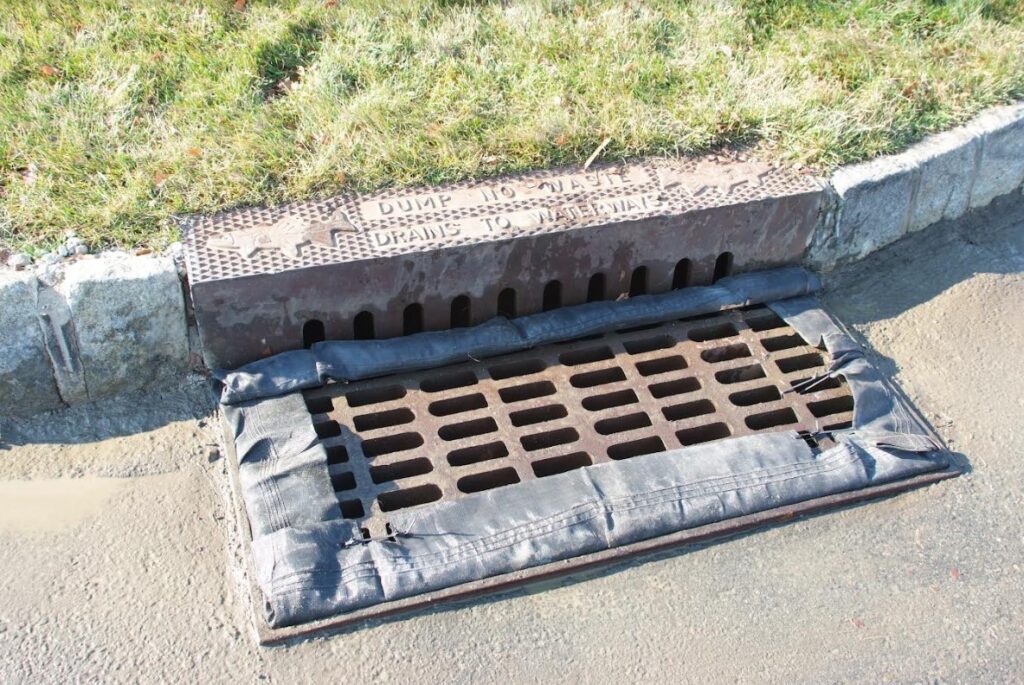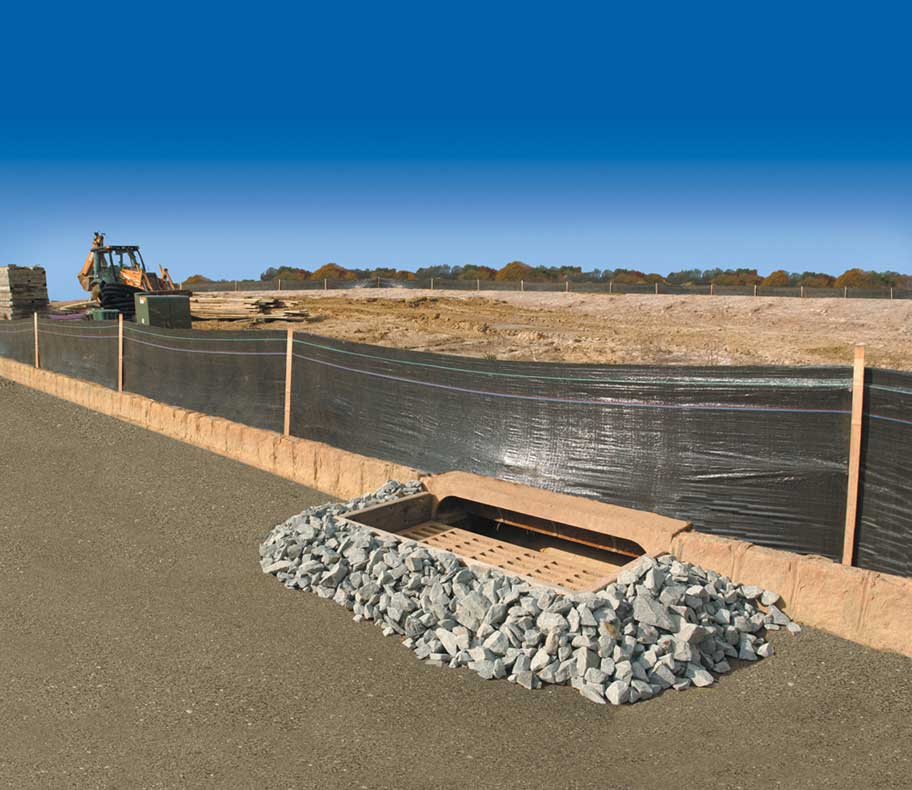
In construction and property management in New Jersey, maintaining the integrity of storm drain inlets is a critical task that may go unnoticed. These inlets, responsible for transferring flow downstream, serve as essential links in both surface and subsurface systems and they playing an important role in preventing flooding and managing runoff effectively.
Inlet protection prevents blockages where these openings can quickly become sediment traps, clogging storm drain pipes and disrupting the entire drainage system.
Eastcoast Site Work, based in Freehold, New Jersey, has experience in various storm drain inlet protection methods and helpful products that offer preventative solutions and provide erosion control. Whether it’s basin and pond maintenance, hydroseeding, or providing silt fences, Eastcoast Site Work ensures that storm drain inlets are safeguarded against the elements.
While surface drainage ditches can offer some level of protection, they are often insufficient in tackling larger debris and sediment loads. There are various complimentary methods that can be employed to protect storm drain inlets effectively. You must understand the benefits and drawbacks of each method to choose the best solution for your specific needs. New Jersey construction professionals, large commercial property owners and HOA organizations looking to maintain the longevity and functionality of their property’s drainage system would benefit from knowing the information presented here.
The Need for Storm Drain Inlet Protection
In New Jersey construction and property management, storm drain inlets must be protected. These inlets are key components of the stormwater drainage system, responsible for directing water flow downstream to prevent flooding and manage runoff.
The Problems with Unprotected Storm Drains
Storm drains can quickly become sediment traps without protection. This is particularly true for drop inlets, a type of storm drain inlet that is especially prone to such issues. When sediment accumulates, it can lead to clogged storm drain pipes, disrupting the entire drainage system. This not only leads to ineffective water management but also increases the risk of property damage due to flooding.
Moreover, the lack of inlet protection devices can make the system vulnerable to larger debris, causing further blockages. To filter sediment effectively and prevent these issues, specialized inlet protection is necessary.
Environmental Implications of Unprotected Storm Drains
The environmental implications of unprotected storm drains are significant as well. When storm drains become clogged, they can overflow, leading to uncontrolled runoff. This can result in soil erosion and the displacement of natural habitats in the surrounding area. Furthermore, the sediment and pollutants that accumulate in the storm drains can be carried off by the runoff, polluting local water bodies and harming aquatic life.
The unchecked flow of stormwater can also contribute to the degradation of infrastructure over time. It can cause roads to deteriorate faster, increasing maintenance costs and potentially leading to hazardous conditions for motorists.
Eastcoast Site Work: Your Partner in Storm Drain Inlet Protection
With over 20 years of experience in the construction industry, Eastcoast Site Work is a trusted partner in erosion control and soil sediment control services in New Jersey. We specialize in providing comprehensive solutions for basin and pond maintenance, inlet protection, and hydroseeding on construction sites and properties. Our inlet protection devices are designed to filter sediment effectively, preventing the clogging of storm drain pipes and promoting a healthier environment.
Whether you’re a construction professional, part of a property management or HOA organization, or a large commercial property owner, understanding the importance of storm drain inlet protection is crucial. With the right knowledge and resources, you can take proactive steps to protect your storm drains, maintain the integrity of your property, and contribute to environmental conservation. At Eastcoast Site Work, we’re committed to providing you with the tools and services you need to achieve these goals.
Methods of Storm Drain Inlet Protection
Storm drain inlet protection is vital in managing runoff effectively and preventing flooding. There are several methods available for protecting storm drain inlets, each with its own benefits and drawbacks. Let’s delve into some of these methods, from silt fences and inlet filters to gravel and stone filters and geotextiles.
Silt Fences
Silt fences are one of the most commonly used methods for inlet protection. They work by acting as a barrier that intercepts and slows down the flow of water, allowing sediment to settle before water reaches the storm drain inlet. This helps prevent the inlet from becoming a sediment trap and keeps the stormwater drainage system functioning effectively.
Pros: Silt fences are relatively inexpensive and easy to install. They can be effective at trapping sediment and are suitable for use around construction sites.

Cons: Silt fences require regular maintenance to ensure they remain effective. They may not be suitable for areas with heavy water flow as they can become overwhelmed and fail.
Inlet Filters
Inlet filters work by being placed inside the drop inlet or catch basin of a storm drain system. They filter out sediment and other debris before it has a chance to enter the system.
Pros: Inlet filters are highly effective at removing sediment and are easy to maintain. They also help prevent clogging of the storm drain system.
Cons: Inlet filters can be more expensive than other methods and may not be suitable for all types of storm drain inlets. Additionally, if not properly maintained, they can lead to the inlet discharging unfiltered water.

Gravel and Stone Filters
Gravel and stone filters are often used in conjunction with other methods such as silt fences or inlet filters. They work by slowing down the flow of water, allowing sediment to settle before it reaches the storm drain inlet.
Pros: Gravel and stone filters are durable and can handle large volumes of water. They can be effective in areas where only surface drainage ditches are available.
Cons: These filters can be expensive to install and may require regular maintenance to ensure they remain effective. They may also not be suitable for areas prone to heavy sediment loads.
Geotextiles
Geotextiles are permeable fabrics used in association with soil and have the ability to separate, filter, reinforce, protect, or drain. When used for storm drain inlet protection, they work by allowing water to pass through while trapping sediment.
Pros: Geotextiles are versatile and can be used in a variety of applications. They are durable and require less maintenance compared to other methods.
Cons: Geotextiles can be more expensive than other methods and may not be suitable for all situations. They also may require professional installation.
The Importance of Effective Inlet Protection
The protection of storm drain inlets is not just a matter of infrastructure maintenance; it’s about safeguarding our communities and the environment from the detrimental effects of uncontrolled runoff and sediment transfer. The methods of inlet protection, including silt fences, inlet filters, gravel and stone filters, and geotextiles, each play a crucial role in managing stormwater effectively and ensuring the inlet transferring flow downstream remains unobstructed.
It’s imperative for construction professionals, property managers, and concerned citizens alike to understand these methods and their importance. By prioritizing storm drain inlet protection, we contribute to the overall health of our water systems, reduce the risk of property damage, and uphold our commitment to environmental conservation.

